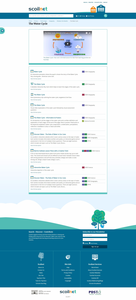Learning Path
Rain Learning Path
By Moira Lambe
Use the lessons and activities in this Learning Path to learn all about Rain.
7 resources in this Learning Path
Rain & Floods Explained
http://www.weatherwizkids.com/weather-rain.htm Added: 19 Sep 2010 Contributor: Scoilnet Resource type: ReferenceThis comprehensive site explains how rain is formed, what flash floods are and how a doppler radar works. clear description.
View full descriptionHow it maps to the curriculum
- 5-6
- SESE Geography
5-6
5-6
5-6
5-6
Strand: Natural Environments
Strand unit: Weather, Climate & Atmosphere
Suggestions for use: none
The Water Cycle - Themepage
https://www.scoilnet.ie/index.php?id=989 Added: 21 Mar 2017 Contributor: Emer Ní Chéidigh Resource type: Guide/notes / Audio / VideoHere are resources and videos to support the teaching of the water cycle. There are links to websites, presentations and flip charts about the water cycle.
View full descriptionHow it maps to the curriculum
How To Read A Weather Map
http://www.fbd.ie/CreativeContentHu.../how-to-read-a-weather-map/desktop/ Added: 20 Nov 2015 Contributor: Scoilnet Resource type: Guide/notesHighly visual guide to understanding and interpreting weather maps. Covers the symbols on a map, UV measurements, air pressure, extreme weather warnings and isobars. It also examines the people who rely on weather forecasting, and how weather conditions affect people in their day-to-day lives.
View full descriptionHow it maps to the curriculum
Strand: Mapping & Geog Skills
Suggestions for use: This site would display very well on the class computer or IWB. Take the time to plan a class using this as the core resource.
Strand: Mapping & Geog Skills
Suggestions for use: This site would display very well on the class computer or IWB. Take the time to plan a class using this as the core resource.
- JC
- Geography
JC
JC
JC
Strand: 1. Exploring the Physical World
Strand unit: 8. Gather, Record & Interpret Weather Data
Suggestions for use: Excellent to introduce students to basic understanding of weather and the things to look at when reading a weather forecast.
Key Skills: Managing Information and Thinking
Rain - Met Éireann
https://www.scoilnet.ieuploads/resources/25889/25625.pdf Added: 27 Feb 2018 Contributor: Scoilnet Resource type: Guide/notesPDF document from Met Éireann education with fun facts on the topic of rain including facts on the the water cycle, raindrops, measuring rain, floods, rainbows, snow, sheet and hail.
View full descriptionHow it maps to the curriculum
- JC
- Geography
Strand: 1. Exploring the Physical World
Strand unit: 8. Gather, Record & Interpret Weather Data
Measuring and Recording Rain - Met Éireann
https://www.scoilnet.ieuploads/resources/25900/25636.pdf Added: 27 Feb 2018 Contributor: Scoilnet Resource type: Lesson PlanPDF lesson plan from Met Éireann on 'Measuring and Recording Rain'. The document guides teachers through an activity where students build a rain gauge, record data and analyse results.
View full descriptionHow it maps to the curriculum
- JC
- Geography
Strand: 1. Exploring the Physical World
Strand unit: 8. Gather, Record & Interpret Weather Data
Powerpoint presentation-How rain/hail/sleet/snow are formed
https://www.scoilnet.ieuploads/resources/34896/34655.pptx Added: 22 Nov 2020 Contributor: Niamh Carroll Resource type: PresentationA presentation explaining how rain, hail, sleet and snow are formed. This presentation explains the similarities and differences between each of these forms of precipitation and provides some key word explanations.
View full descriptionHow it maps to the curriculum
- 5-6
- SESE Science
5-6
Strand: Materials
Strand unit: Properties and characteristics of materials
Content objective:
This resource should enable a child to:
- identify and investigate a widening range of common materials in the immediate environment
- recognise that materials can be in solid, liquid or gas form
Suggestions for use: For use in a lesson about the various forms that water can take within our environment.
- 5-6
- SESE Geography
Strand: Natural Environments
Strand unit: Weather, Climate & Atmosphere
Content objective:
This resource should enable a child to:
- become aware of the characteristics of some major climatic regions in different parts of the world
- develop simple understanding of some atmospheric features
- explore weather patterns over the year in the locality using a variety of graphical and analytical skills
Suggestions for use: For use in a lesson about features of winter weather, common features of Irish weather or precipitation.
Video of the Water Cycle
https://www.youtube.com/watch?v=gY9HG8zUgOE Added: 19 Jul 2016 Contributor: Aine Seagrave Resource type: Audio / VideoFun video about the entire water cycle with this video clip. There are analogies and examples used in the video to help explain the water cycle. The ideas from the video could be used in completing a science fair project. Pupils will learn how rain happens by finding out what evaporation and condensation mean.
View full descriptionHow it maps to the curriculum
- 3-4
- SESE Geography
Strand: Natural Environments
Strand unit: Land, Rivers, Seas of My County
Content objective:
This resource should enable a child to:
- become familiar with the names and locations of some major natural features in the county
- develop some familiarity with the relationship of these features with each other and with elements of the built environment such as roads, bridges, towns and cities
Suggestions for use: Set questions for pupils to answer from watching the video clip. Set up the jug of water activity in your classroom and see does the level of water change in the jug over a certain among of time. Ask your class what they think will happen to the water beforehand.



